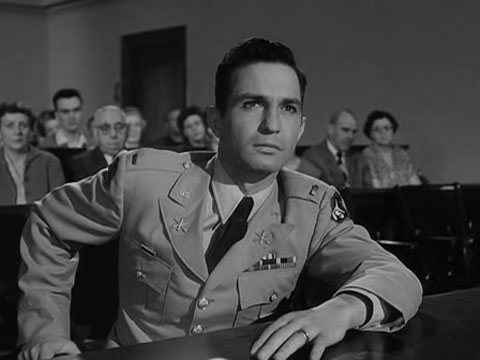And in Otto Preminger's Anatomy of a Murder, a courtroom drama, you have Jimmy Stewart, the defense attorney, sitting behind one bench, and George C. Scott, the prosecutor, behind the other. These two men are colossal figures in the world of cinema, and could easily be found atop many lists that rank the greatest actors of all time. Watching these two men go toe-to-toe, albeit in a much different sense than Ali-Frazier, is nothing short of brilliant. Not only are they coexisting on the same set, but they are actually going against each other, in a courtroom setting, working directly off one another.
The film, made over 50 years ago, is directed by Preminger (who also directed the classic 1944 film noir, Laura), and features a screenplay by Wendell Mayes, which is based on a novel of the same name by John D. Voelker. Voelker, who once worked as supreme court justice in Michigan, based the novel on a 1952 murder trial, in which he was the defense attorney. As a result, Anatomy of a Murder is authentic as they come.
The film takes place in the Upper Peninsula of Michigan, and Jimmy Stewart plays small-town lawyer Paul Biegler. Bear in mind that this is an older Stewart, and not the "aww shucks" variety from his days of Mr. Smith Goes to Washington and It's a Wonderful Life. This is the elder, grizzled Stewart who had already teamed up with Alfred Hitchcock to make Rear Window and Vertigo.
Biegler may be small-town, but he's got the experience. The man he is defending is army Lieutenant Frederick Manion, played by the recently deceased Ben Gazzara, who has just killed a man named Barney Quill. Manion, who openly admits that he killed Quill, says he did it because Quill had raped his wife, Laura (Lee Remick), hours earlier. Laura backs the story, and Biegler agrees to take the case, recruiting the help of his friend and colleague, Parnell McCarthy (Arthur O'Connell), an old has-been lawyer who has a penchant for the drink.
Like all courtroom dramas, one of Anatomy of a Murder's primary themes is legal ethics. Is murder justified if it is in retaliation of rape? Legally, it isn't, but it is when the suspect suffered from temporary insanity while he committed it, which is the story that Manion goes with. Biegler never questions the authenticity of Manion's story, that's not his job -- his job is to get him acquitted. But Biegler isn't devoid of ethics or morals, proven when he warns the Manions right before the trial, "Now when you get up on that stand, I want you to tell the truth. I don't want you to tell anything but the truth, don't try and lie, don't try and conceal anything, or you'll get skinned alive."
 |
| Jimmy Stewart, right, arguing with Brooks West, with George C. Scott observing in between. |
Twists, turns and surprises will abound in any good courtroom drama, and Biegler's first surprise comes at the start of the trial, when the local D.A. Mitch Lodwick (Brooks West) announces that he will be assisted in the case by hotshot assistant Attorney General (Scott), who came all the way up from Lansing due to the "peculiar nature" of the case, according to Lodwick.
The trial starts, and as witness after witness is sworn, questioned and occasionally bullied, we watch Stewart and Scott go to work. They play off each other extremely well, with Stewart's witty, passionate bordering on temperamental demeanor versus Scott's even-keeled, efficient, yet equally as witty demeanor. Both actors give the utmost credibility to their characters, which in turn makes the viewer eager to see the strategies that both men employ and improvise throughout the case.
The prosecution tries its hardest to keep the motive of the murder, which was the alleged rape, away from the murder trial, but Biegler argues that his temporary insanity plea is contingent on the rape, and thus, its involvement is necessary. After deliberation, the judge, played affably by Joseph Welch, agrees, which helps muddle things up even more. From there, more twists and turns develop, which culminate in the final verdict.
I said earlier that Stewart plays his character with a little more grit than we may be accustomed to, but the Stewart of old is still there, and he still posseses that warm twinkle of amiability as his character occasionally goes off on dull but humorous tangents, like, for example, his love for fishing.
 |
| Ben Gazzara as Lt. Frederick Manion. |
There are no protagonists or antagonists in Anatomy of a Murder. Each character has their own shades of black and white, but like the color of the film itself, each lies within the shade of grey in the moral color spectrum. In the trial, each character has their own job and agenda, and each do it admirably. At two hours and forty minutes, the film is long, but one should expect it to be, for to dissect the anatomy of a murder is surely no quick task.
~ Review by Ddubbs


No comments:
Post a Comment